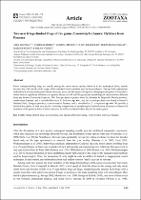| dc.contributor.author | Batista, Abel | |
| dc.contributor.author | Hertz, Andreas | |
| dc.contributor.author | Mebert, Konrad | |
| dc.contributor.author | Köhler, Gunther | |
| dc.contributor.author | Lotzkat, Sebastian | |
| dc.contributor.author | Ponce, Marcos | |
| dc.contributor.author | Vesely, Milan | |
| dc.date.accessioned | 2019-08-27T19:32:14Z | |
| dc.date.available | 2019-08-27T19:32:14Z | |
| dc.date.issued | 2014 | |
| dc.identifier.issn | ISSN 1175-5334 (online edition) | |
| dc.identifier.uri | http://jadimike.unachi.ac.pa/handle/123456789/99 | |
| dc.description | Forest canopy-dwelling frogs are usually among the rarest anuran species observed in the neotropical forest, mainly
because they fall outside of the scope of the standard search methods used by herpetologists. During field explorations
undertaken in western and eastern Panama in recent years, we discovered two species belonging to the genus Ecnomiohyla,
which showed significant differences in genetic distances (16S mtDNA gene) and morphological characteristics different
from any known Ecnomiohyla species. The first specimen originates from the Serranía de Jingurudó, Darién province,
southeastern Panamá, and is described herein as E. bailarina sp. nov., and the second specimen was found at Santa Fe
National Park, Veraguas province, central-western Panama, and is described as E. veraguensis sp. nov. We provide a
detailed description of both new species, including comparisons of morphological and molecular characters of almost all
members of the genus in lower Central America, as well as an identification key for the entire genus. | es_ES |
| dc.description.abstract | Forest canopy-dwelling frogs are usually among the rarest anuran species observed in the neotropical forest, mainly
because they fall outside of the scope of the standard search methods used by herpetologists. During field explorations
undertaken in western and eastern Panama in recent years, we discovered two species belonging to the genus Ecnomiohyla,
which showed significant differences in genetic distances (16S mtDNA gene) and morphological characteristics different
from any known Ecnomiohyla species. The first specimen originates from the Serranía de Jingurudó, Darién province,
southeastern Panamá, and is described herein as E. bailarina sp. nov., and the second specimen was found at Santa Fe
National Park, Veraguas province, central-western Panama, and is described as E. veraguensis sp. nov. We provide a
detailed description of both new species, including comparisons of morphological and molecular characters of almost all
members of the genus in lower Central America, as well as an identification key for the entire genus. | es_ES |
| dc.language | spanish | |
| dc.language.iso | en | es_ES |
| dc.publisher | MagnoliaPress | es_ES |
| dc.relation | none | |
| dc.relation.ispartofseries | Zootaxa; | |
| dc.rights | info:eu-repo/semantics/openAccess | |
| dc.subject | fringe-limbed frogs | es_ES |
| dc.subject | ecnomiohyla | es_ES |
| dc.subject | DNA barcoding | es_ES |
| dc.subject | lower Central America | es_ES |
| dc.subject | Panama | es_ES |
| dc.title | Two new fringe-limbed frogs of the genus Ecnomiohyla (Anura: Hylidae) from Panama | es_ES |
| dc.type | Article | es_ES |
| dc.type | info:eu-repo/semantics/article | |
| dc.type | info:eu-repo/semantics/publishedVersion | |

